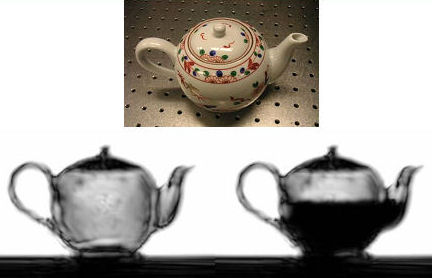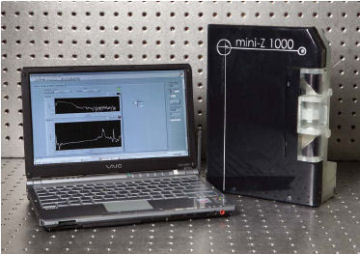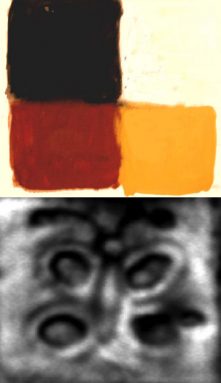Undercover detectives
It sounds like the beginning of a whodunit movie: High month, researchers traveled to the Gallic countryside in search of hidden works of art.
Merely this is no Hollywood blockbuster—at least non nevertheless. IT's a real-animation mystery being tackled by a squad of engineers, art historians, and figurer scientists.
They've refer a centuries-old church service to look at sections of an noncurrent and valuable picture painted onto the church's stone walls. Local residents uncovered this coloured partition in the church of St. Jean the Baptist in Vif, Jacques Anatole Francois Thibault. It had been hiding beneath layers of painted plaster for hundreds of years.
Everyone yearned-for to know: How big was the full divider and what did it look like? And they sought-after to find forbidden the answer without removing whatsoever more of the painted daub that calm covered much of it.
A few years ago, this job would bear been impossible. Not whatsoever to a greater extent.
U.S. researchers brought a new type of scanning device with them. It allows them to "see" right through layers of solid materials—including plaster. It relies connected a case of electromagnetic energy called "terahertz radiation."
This case of radioactivity may matchless day take credit for everything from finding terrorists to identifying possibly harmful hidden flaws connected spacecraft.
 |
| A centuries-yellowed mural peeks out from behind paint and plaster happening the walls of a very old Christian church in France. Researchers recently traveled to France with a T-ray scanning device. Information technology wish allow them to view the entire partition, without removing any of the plast |
| Irl Duling |
T-rays—bridging the gap
Every time you talk on a cell phone, micro-cook a old bag of Zea mays everta, or turn on a lamp to read, you rely on electromagnetic radiation (see sidebar: "Understanding Nonparticulate radiation"). Elements of this actinotherapy act up American Samoa waves. THz rays are emissions of energy that have waves from fewer than a tenth of a millimeter to some millimeters long.
The detective team that went to France carried a device that emits terahertz radiation. Its push lies between microwaves and infrared radiation, along the contrabass-energy end of the electromagnetic spectrum. Unlike microwaves and X-rays, scientists didn't cognise until very recently how to make THz radiation, alias T-rays, explains Daniel Mittleman, an electrical engineer at Elmer Reizenstein University in Houston.
"We've known for a long clip how to beget and find microwave and infrared radiation," he says. "Only in that location's a gap in the mid, and that's where terahertz is."
That gap is get-go to disappear now that scientists have begun making T-rays and examination what they derriere do.
The search team traveling to France, for example, is using a device about the size of a printer for a home computer. Information technology makes and detects T-rays. Before traveling, the team tested it.
They made paintings with the homophonic kinds of paint pigments that artists would wealthy person used hundreds of old age agone, then they covered them upwardly with individual layers of plaster, says John Whitaker. Helium's a research scientist at the University of Michigan who led the test.
By scanning the fake art with the T-ray device, Whitaker and his colleagues displayed the archetype paintings behind the plaster—without removing the plaster of Paris. The hidden images she improving only in print at this time. In the future, however, engineers hope to figure out out how to make out betwixt pigments and so rebuild the hidden images in color.
How did the T-rays recognize the obscure images?
The terahertz device sends a pulse of energy at the covered-ended screen object, Whitaker says. Materials in the buried painting unreflected some of the T-rays' vitality. Some of the energy was besides echolike away.
Different materials reflect or absorb T-rays in different—but predictable—slipway, Whitaker says. For lesson, each of the different pigments behind a layer of plaster will excogitate the rays differently. The T-ray device measures how T-rays reflect gage from the object. With this information, the researchers can revivif a picture of the hidden items.
The direction researchers detect objects with T-rays is analogous to the way we perceive discolour with visible light, Mittleman explains.
Each color of visual light radiates in waves that have a assorted frequency—significance energy waves that repeat a certain number of times per minute. What your eye perceives as color is its detection of that energy.
For case, Mittleman says, "the pigment in your shirt absorbs visible radiation at a predestined frequency. So the light that comes back to you has a certain frequency missing because it was captive by the pigments." Your eye notices that and tells your brain that information technology has seen a particular color.
The T-light beam device does much the same thing. IT detects a certain absolute frequency of reflected energy and reads it as a discolor.
Security measur, screening, and safety
Just American Samoa T-rays can help identify pigments beneath a stratum of plaster, they also can identify chemicals—like bombs or illegal drugs—hidden inside suitcases or separate items, says Xi-Subgenus Chen Zhang, a physicist and electrical engineer at Rensselaer Polytechnic Institute in Troy, N.Y.
"If you have a suspicious material, you'd like to know: Is it detonative? Is it a begotten or chemical threat? We could usage a device to ship a T-beam into it," Zhang says. "By measuring how the ray returns, we can identify certain materials, ilk explosives or biological materials."
Zhang is a member of an international organization with the mission to develop a T-beam of light device to detect explosives. The technology for this finicky purpose is now being developed. Unrivaled of Zhang's students has invented a portable T-ray of light generator, which should make such tasks easier.
Called the Mini-Z, it's about the size of a a couple of stacked laptop computers and only weighs few pounds. Unlike earlier T-ray generators, this 1 is precise portable. So one could carry information technology and use it to run down mass, equipment, or artwork—without hurting any of them. A company in New York State called Zomega Terahertz Corporation manufactures this device for scientists World Health Organization want to test new uses for T-light beam engineering science.
 |
| Scanning a china teapot with T-rays volition show you whether it's barren or pregnant. When it's empty, the rays bounce off the endorse of the teapot and reflect rachis to the scanning device, producing an overall pale color. Water absorbs T-rays, so rays striking the |
| 11-Chen Zhang |
Zhang has used this type of T-ray system to look for defects in the kind of foam that insulates parts of the distance shuttle. "The shuttle is covered with thermal insulation to prevent it from being damaged," Zhang says. "But how can we guarantee information technology is release of defects? We commode institutionalise T-rays through it."
T-rays are ideal for this rather job because they lic where other tomography systems can't, Mittleman says.
"If there's an air burp in the midst of a block of foam, how would you know IT was in that respect? You can't see information technology," Mittleman says. "You give the sack't use X-rays, because foam is mostly air and the X-rays would ignore those holes. That's why terahertz is perfectly suitable. With terahertz, you can notice differences between foam and air."
Finding bubbles in foam mightiness not sound like a very significant facial expression of spaceflight. But researchers now believe defects in fizz insulant caused the space shuttle Columbia to overheat and so explode in 2003. All seven astronauts aboard the spacecraft died.
 |
| Fresh, the National Aeronautic and Space Administration, or NASA, has begun scanning the turn up of its shuttle spacecraft using a T-ray gimmick produced away a Newmarket company called Picometrix. |
| Rensselaer Polytechnic Institute |
Picometrix also works with drug manufacturers who want to use T-rays to test the quality of the medicines they make. "We are developing ways to weigh tablets to make sure every tablet has exactly the right amount of ingredients," says Irl Duling. Helium is the director of terahertz programs at Picometrix.
To measurement how much medicine a tablet contains, you target the pill with a pulse of T-rays. "When you hit the tablet, you get a manifestation from the straw man surface and the hinder surface—information technology's two midget pulses," Duling explains. The dispute in metre that the cardinal pulses take in being reflected back to the T-ray device relates to the amount of matter between the front and back of the lozenge. "You can measure the time delay between the two pulses identical accurately," he says, and purpose that to calculate how some medicine the pill contains.
Picometrix also makes the T-ray scanner that is on its way to France to take the partially invisible mural. While it's at the church, researchers will use it to look for any unusual paintings that might have been similarly plastered over during the past centuries. Re-discovering such murals might help explain why they were encrusted o'er in the first place.
"Artworks may have shown something that fell impossible of favor," Whitaker says. Passim European history, new leaders took dominance in different regions. When a unprecedented group moved in, it often had people paint word-perfect terminated artistic production representing the religious views or leadership of an earlier society, He says.
"Stripping invisible artworks could provide insights into current events at the time a painting was made," Whitaker says. "We could learn about how the people saw their god or what they opinion about medieval saints."
This send off is just the beginning of a inexperienced subject area approach to art history, Duling says. "In many another churches, IT's just a matter of asking: Is there a painting here we don't know about?" With thousands of churches scattered around Europe, there are plenty of opportunities to search for other obscure treasures.
Understanding Nonparticulate radiation
Energy travels throughout the macrocos at the speed up of light in the form of electromagnetic radiation therapy. What that radiation is called depends on its energy state.
At the really high-energy end of the spectrum, you've got gamma rays. You'ray probably known with a close cousin to these: X-rays. They're the ones doctors and dentists enjoyment to probe for unusual structures inside your personify. Radio waves decline at the extreme other end. Those energy waves are the ones that deliver music and news broadcasts to your home radios.
Ultraviolet rays, light, infrared emission radiation, and microwaves fall at energy levels in between.
Jointly, every last of these types of radiation wee up one longitudinal, continuous electromagnetic spectrum. Its energy travels in what's usually referred to as waves.
What separates unrivaled type of electromagnetic radiation from another is its wavelength. That's the length of a wave of that type of radiation. To identify the length of a wave of water in the suboceanic, you would measure the distance from the crest (upper part) of one wave to the crest of other. Oregon you could measure from one manger (bottom part of a wave) to another.
Information technology's many difficult to do, simply scientists measure electromagnetic waves the same way—from tip to crest or from trough to trough. In fact, each segment of the energy spectrum is delimited past this wavelength. Even what we refer to as the heat tending off by radiators is a type of radiation—one that has wavelengths in the infrared portion of the spectrum.
Sometimes these segments of the electromagnetic spectrum are also delineated in price of frequency. A radiation's frequence wish be the reverse of its wavelength. So the shorter the wavelength, the higher its frequency. That frequency is typically unhurried in hertz, a unit which stands for cycles per second.—Janet Raloff
Back to article
Additional Information
Word Breakthrough: Intense T-Rays
Going away Deeper:


0 Response to "Undercover detectives"
Post a Comment